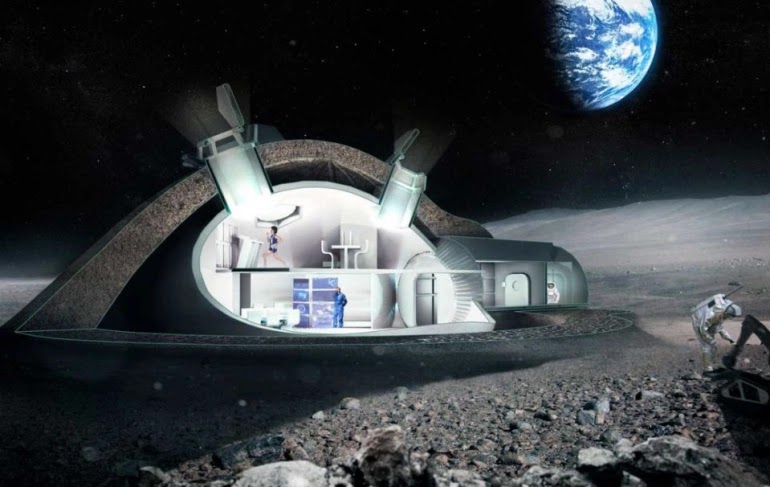Technology is a vital element in preparing for a permanent lunar base, which is what a British company is striving to achieve.
In a report published by the British newspaper The Guardian, writer Jan Sampel said that a British company won a contract with the European Space Agency (ESA) to develop a technology to convert dust and rocks on the surface of the moon into oxygen. With aluminum, iron and other metal powders left for construction workers to work.
If this process is successful, it will pave the way for concentrating drilling and extraction facilities on the surface of the moon to produce oxygen and other valuable materials, rather than having to transport them to space at great costs.
“Everything that you carry from Earth to the Moon constitutes additional weights that you may not basically want to carry,” said Jan Millor, CEO of Metalysis, a Sheffield-based company. So, if we succeed in producing these materials there, We will save a lot of time, effort and money. “
The author stated that analyzes of rocks brought from the moon reveal that oxygen constitutes about 45% of the material. The remainder is distributed widely between the metals iron, aluminum and silicon.
In a study published this year in Planetary and Space Science, scientists at Metalysis and the University of Glasgow found that they were able to extract 96% of the oxygen from soil similar to lunar soil, leaving behind them. Useful metal alloy powders.
Lunar Village Supplies
The US space agency “NASA” (Nasa) is participating with other space agencies in advanced preparations for returning to the moon, in order to establish a permanent lunar base, or what they called “the village of the moon”, where countries will work in cooperation with private companies to develop vital technologies such as support Life forms and building habitats for living, generating energy, producing food and building materials.
The writer noted that the European Space Agency contract would provide funding for a project by the company “Metalyss” for a period of 9 months to perfect an electrochemical process that produces oxygen from moon dust and rocks by sending an electric current through the material.
It is reported that this process is already dependent on the Earth’s surface. In contrast, oxygen is produced as an unwanted by-product resulting from mineral extraction. To ensure the success of this process on the lunar surface, the oxygen produced must be captured and stored.
The writer stated that according to the contract between the European Space Agency and the British company, “Metalyss” will try to enhance the productivity and purity of oxygen and minerals extracted from rocks while reducing the amount of energy consumed in the production process. If this technology shows promise, the next step will be to extract oxygen from the surface of the moon.
Moreover, the oxygen extracted from the surface of the moon can be combined with other gases to produce breathable air, although it is also a vital component of rocket fuel that can be manufactured on the moon and used to fuel space vehicles heading to space.
In this context, Melor said, “If you want to penetrate into the heart of space, the presence of a fuel station on the surface of the moon is an essential step to reach deep space.”
There is no free oxygen
Mark Symes, who is involved in the process at the University of Glasgow, said moon rocks represent a “tremendous potential source of oxygen” to support human exploration of the moon and the wider solar system. “Oxygen is not only useful for astronaut breathing, but it is also an oxidizing agent in missile propulsion systems,” he added.
And there is no free oxygen on the moon. Therefore, astronauts must carry with them enough oxygen to the moon, to support life and be able to return to Earth. In general, this adds significant dimensions in terms of weight, and thus affects the calculations of launches of missiles heading to the Moon.
“If we want to travel on a large scale in the future to space and establish bases on the surface of the moon and Mars, we will need to make or find the things required to support life there,” the writer said, quoting Sue Horn, head of exploration at the UK Space Agency. Similar to food, water and breathable air. “
For more than 4 decades, human space exploration has been limited to missions to the International Space Station, an orbital base 220 miles above the Earth’s surface. It is expected that the focus in the coming years will be on building a new station in orbit around the moon, which will serve as a stopping point for humans to establish their presence on the surface of the moon, and perhaps as a central base for the launch towards Mars.
In a related context, the “Lunar Gateway” program has set itself an ambitious goal of returning humans to the moon in early 2024, with the transfer of crews on board the “Orion” spacecraft of NASA.
The missile is expected to make its first flight without a human crew during the next year. The European Space Agency has provided missile power and propulsion units for the first “Orion” flight, and the agency has also approved contracts to build major human crew units on the future lunar station.


